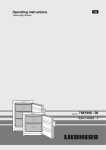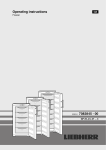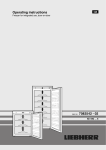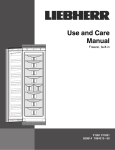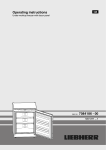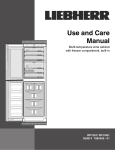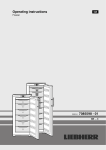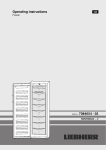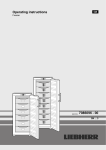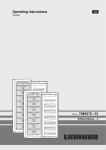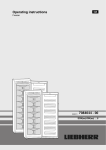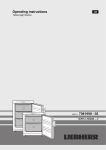Download Liebherr GNP 2303-21
Transcript
Operating instructions Freezer 030712 7081986 - 01 GN 2303 ... 3 Appliance at a glance Contents 1 1.1 1.2 1.3 1.4 1.5 1.6 Appliance at a glance............................................ Description of appliance and equipment.................. Range of appliance use............................................ Conformity................................................................ External dimensions of the appliance....................... Saving energy.......................................................... Insulation plate......................................................... 2 2 2 3 3 3 3 2 General safety information................................... 3 3 3.1 3.2 Controls and displays........................................... Operating and control elements............................... Temperature display................................................. 4 4 4 4 4.1 4.2 4.3 4.4 4.5 4.6 4.7 Putting into operation............................................ Transporting the appliance....................................... Installing the appliance............................................. Changing over the door hinges................................ Insertion into a row of kitchen units........................... Disposing of packaging............................................ Connecting the appliance......................................... Switching on the appliance....................................... 4 4 4 5 6 6 7 7 5 5.1 5.2 5.3 5.4 5.5 5.6 5.7 5.8 5.9 5.10 5.11 5.12 5.13 5.14 Control.................................................................... Brightness of the temperature display...................... Child proofing........................................................... Door alarm................................................................ Temperature alarm................................................... Freezing food........................................................... Storage life............................................................... Thawing food............................................................ Setting the temperature............................................ SuperFrost............................................................... Drawers.................................................................... Shelves.................................................................... VarioSpace............................................................... Drawer for herbs and berries.................................... Cold storage accumulators....................................... 7 7 7 7 8 8 8 8 8 8 9 9 9 9 9 6 6.1 6.2 6.3 Maintenance........................................................... 9 Defrosting with NoFrost............................................ 9 Cleaning the appliance............................................. 9 Customer service..................................................... 10 7 Malfunction............................................................. 10 8 8.1 8.2 Decommissioning.................................................. 10 Switching off the appliance....................................... 10 Taking the appliance out of service.......................... 11 9 Disposing of the appliance................................... 11 The manufacturer works constantly on the further development of all the types and models. Therefore please understand that we have to reserve the right to make design, equipment and technical modifications. To get to know all the benefits of your new appliance, please read the information contained in these instructions carefully. Instructions for action are marked with a action are marked with a . , the results of 1 Appliance at a glance 1.1 Description of appliance and equipment Note u Shelves, drawers and baskets are arranged for optimum energy efficiency on delivery. 2 (1) Transport grips at back (2) Operating and control elements (3) NoFrost (4) Herb and berry tray (5) Cold storage accumulator Fig. 1 (6) Type plate (7) Drawers (8) VarioSpace (9) Height-adjustable feet, transport grips at front, transport castors at back 1.2 Range of appliance use The appliance is suitable solely for cooling food in a domestic environment or similar. This includes use in, for example - in staff kitchenettes, bed and breakfast establishments, - by guests in country homes, hotels, motels and other forms of accommodation, - in catering and similar services in the wholesale trade Use the appliance solely as is customary within a domestic environment. All other types of use are inadmissible. The appliance is not suitable for storing and cooling medicines, blood plasma, laboratory preparations or similar substances and products covered by the 2007/47/EC Medical Devices Directive. Misuse of the appliance can result in the stored products suffering harm or perishing. Furthermore, the appliance is not suitable for operation in potentially explosive atmospheres. The appliance is set to operate within specific ambient temperature limits according to its climate rating. The correct climate rating for your appliance is indicated on the type plate. Note u Compliance with the ambient temperatures indicated is required, otherwise the cooling performance is reduced. Climate rating for ambient temperatures SN, N up to 32 °C ST up to 38 °C T up to 43 °C The appliance will function properly in ambient temperatures of down to 5 °C. General safety information 1.3 Conformity 2 General safety information The refrigerant circuit is tested for leakage. The appliance complies with the relevant safety regulations and EC Directives 2006/95/EC, 2004/108/EC, 2009/125/EC and 2010/30/EU. Danger for the user: - This appliance is not designed for persons (including children) with physical, sensory or mental impairment or persons not having sufficient experience and knowledge, unless they are instructed in the use of the appliance and are initially supervised by a person responsible for their safety. Keep children under supervision to ensure they do not play with the appliance. - When disconnecting the appliance from the supply, always take hold of the plug. Do not pull the cable. - In the event of a fault pull out the mains plug or deactivate the fuse. - Do not damage the mains power cable. Do not operate the appliance with a defective mains power cable. - Have any repairs to or intervention in the appliance, and any change of the mains power cable, carried out by the customer service only or by other specialised personnel trained for the purpose. - Install and connect the appliance only as instructed. - Please keep these instructions in a safe place and pass them on to any subsequent owners. Fire hazard: - The refrigerant R 600a is environmentally friendly but flammable. Escaping refrigerant may ignite. • Do not damage the refrigerant circuit pipes. • Do not allow naked flames or ignition sources to enter the appliance. • Do not use any electrical appliances in the interior (e.g. steam cleaners, heaters, ice cream maker etc.). • If refrigerant escapes: remove any naked flames or sources of ignition from the leakage area. Ventilate the room well. Notify the after-sales service. - Do not store explosives or sprays using combustible propellants such as butane, propane, pentane, etc. in the appliance. To identify these spray cans, look for the list of contents printed on the can, or a flame symbol. Gases possibly escaping may ignite due to electrical components. - Keep burning candles, lamps and other items with naked flames away from the appliance so that they do not set the appliance on fire. - Always store high-percentage alcohol in tightly sealed, upright containers. Alcohol possibly escaping may ignite due to electrical components. Danger of tipping and falling: - Do not misuse the plinth, drawers, doors etc. as a step or for support. This applies particularly to children. Danger of food poisoning: - Do not consume food which has been stored too long. 1.4 External dimensions of the appliance Fig. 2 1.5 Saving energy - Always ensure good ventilation. Do not cover ventilation openings or grille. - Do not place appliance in areas of direct sunlight or next to a stove, heater or similar object. - The energy consumption depends on the installation conditions, e.g. the ambient temperature (see 1.2) . - Keep the time the appliance is open to a minimum. - The lower the temperature setting, the higher the power consumption. - Ensure that all food is well packed and covered for storage. This will prevent frost from forming. - First cool warm food to room temperature before storing it . Accumulated dust increases the energy consumption: - Once a year, dust the refrigerating unit together with the metal grille of the heat exchanger at the back of the appliance. 1.6 Insulation plate The insulation plate for part-load operation is available as an accessory from specialist dealers. If you do not store much food in the appliance, you can reduce the power consumption by as much as 50 % by using the insulation plate. Up to 5 drawers can be deenergised, depending on model. At least 3 drawers are necessary for cooling. More information accompanies the insulation plate. Danger of frostbite, numbness and pain: - Avoid lasting skin contact with cold surfaces or refrigerated/ frozen food or take protective steps, e.g. wear gloves. Do not consume ice cream, water ice or ice cubes immediately and do not consume them too cold. Please observe the specific information in the other sections: DANGER identifies a situation involving direct danger which, if not obviated, may result in death or severe bodily injury. WARNING identifies a dangerous situation which, if not obviated, may result in death or severe bodily injury. 3 Controls and displays CAUTION identifies a dangerous situation which, if not obviated, may result in minor or medium bodily injury. NOTICE identifies a dangerous situation which, if not obviated, may result in damage to property. Note identifies useful information and tips. 3 Controls and displays 3.1 Operating and control elements WARNING Risk of fire due to short circuit! If the mains cable/connector of the appliance or of another appliance touch the rear of the appliance, the mains cable/ connector may be damaged by the appliance vibrations, leading to a short circuit. u Stand the appliance so that it is not touched by connectors or main cables. u Do not plug the appliance or any others into sockets located near the rear of the appliance. WARNING Fire hazard due to refrigerant! The refrigerant R 600a is environmentally friendly but flammable. Escaping refrigerant may ignite. u Do not damage the piping of the refrigeration circuit. WARNING Fire hazard and danger of damage! u Do not place appliances emitting heat e.g. microwaves, toasters etc. on the appliance! Fig. 3 (1) On/Off button (2) SuperFrost button (3) Brightness symbol (4) SuperFrost symbol (5) Temperature display (6) Setting button (7) Alarm button (8) Child lock symbol (9) Menu symbol (10) Alarm symbol 3.2 Temperature display The following are displayed in normal operation: - the set freezing temperature The temperature display flashes: - the temperature setting is being changed - after switch-on the temperature is not yet cold enough - the temperature has risen several degrees - the temperature has risen several degrees 4 Putting into operation 4.1 Transporting the appliance CAUTION Risk of injury and danger of damage as a result of incorrect transport! u Transport the appliance in a packed condition. u Transport the appliance upright. u Do not transport the appliance without assistance. 4.2 Installing the appliance WARNING Fire hazard due to dampness! If live parts or the mains lead become damp this may cause short circuits. u The appliance is designed for use in enclosed areas. Do not operate the appliance outdoors or in areas where it is exposed to splash water or damp conditions. 4 WARNING Blocked ventilation openings pose a risk of fire and damage! u Always keep the ventilation openings clear. Always ensure that the appliance is properly ventilated! NOTICE Risk of damage due to condensate! u Do not install the appliance directly alongside a further refrigerator/freezer. q In the event that the appliance is damaged, contact the supplier immediately before connecting to the mains. q The floor at the site must be flat and level. q Do not install the appliance in a location where it is exposed to direct radiation of the sun, next to a cooker, heater and similar. q The ideal installation site is a dry, well ventilated room. q Always stand the appliance with its back directly to the wall. q The appliance may be moved only when it is empty. q Do not install the appliance without assistance. q Standard EN 378 specifies that the room in which you install your appliance must have a volume of 1 m2 per 8 g of R 600a refrigerant used in the appliance. If the room in which the appliance is installed is too small, a flammable gas-air mixture may form in the event of a leakage in the refrigeration circuit. The quantity of refrigerant used in your appliance is indicated on the type plate on the inside of the appliance. u Detach the connecting cable from the rear of the appliance, removing the cable holder at the same time because otherwise there will be vibratory noise! u Remove all transit supports. u Dispose of packaging material (see 4.5) . Putting into operation u Align the appliance so that it stands firmly and on a level by applying the accompanying spanner to the adjustableheight feet (A) and using a spirit level. Note u Clean the appliance (see 6.2) . If the appliance is installed in a very damp environment, condensate may form on the outside of the appliance. u Always see to good ventilation at the installation site. Fig. 5 u Unscrew the turn hinge Fig. 5 (2). u Unscrew the bearing element, Fig. 5 (3) transfer it to the opposite location hole of the turn hinge and screw it firmly into place. u Take the stopper Fig. 5 (4) out of the turn hinge and transfer it to the receiving hole on the opposite side of the turn hinge. u Carefully lift off the cover Fig. 5 (5) on the handle side. u Undo the screw Fig. 5 (6) and transfer it to the opposite side. u Put the cover Fig. 5 (5) back on. u Screw the turn hinge Fig. 5 (2) firmly into place on the new hinge side (with 4 Nm), possibly using a power screwdriver. 4.3 Changing over the door hinges You can change over the door hinges if necessary. Ensure that the following tools are to hand: q Torx 25 q Torx 15 q Open-ended spanner size 6 q Screwdriver q Open-ended spanner included in supply package q Second person for fitting work, if needed CAUTION Risk of injury if the door tips! u Take good hold of the door. u Set down the door carefully. u Unscrew the securing screw on the bottom right turn hinge. u Open the door. u Hold the door on the handle side and at the bottom and lift it. w The bearing pin Fig. 4 (21) should come out of the turn hinge Fig. 5 (2). u If the bearing pin Fig. 4 (21) does not come out, press the pin out from underneath. u Swing door out at the bottom and remove it. Fig. 4 Fig. 6 u At the top, use a screwdriver to unclip cover Fig. 6 (7) and cover Fig. 6 (8) at the front, and remove by pulling out and down. u Unscrew the bearing pin Fig. 6 (9) and screw it firmly into place on the opposite side (with 4 Nm). u Refit the cover Fig. 6 (7) on the side of the bearing pin: insert at the back, snap in at the front. u Fit the cover Fig. 6 (8) on the opposite side: insert at the back, snap in at the front. 5 Putting into operation 4.4 Insertion into a row of kitchen units Fig. 7 u Lift the stopper Fig. 7 (12) out of the door bearing bush and transfer it. u Detach door handle, stoppers Fig. 7 (10) and pressure plates Fig. 7 (11) and transfer to the opposite side. u When mounting the pressure plates, make sure they snap into place properly. u Transfer the spring clamp Fig. 8 (20): Depress the latch nose and pull the spring clamp off over it. u Slide the spring clamp into place on the new hinge side until it clicks into place. u Pull the bearing pin Fig. 8 (21) out of the door bush and transfer it to the opposite side together with the washer. The latch nose must point to the Fig. 8 inner side of the door, the notch to the outer side. u Hang the door on the bearing pin Fig. 6 (9) at the top. u Swing the door in at the bottom and insert the bearing pin Fig. 8 (21) into the turn hinge. If necessary, turn the bearing pin until it snaps into place. u Insert the securing screw Fig. 4 (1) at the bottom into the bearing pin and tighten it (with 4 Nm). u If necessary, align the door flush with the appliance housing using the two slots in the turn hinge. To do so, unscrew the middle screw. WARNING Risk of injury due to the door dropping out! If the bearing parts are not screwed into place firmly enough, the door may drop out. This may lead to severe injuries. What is more, the door may not close and therefore the appliance may fail to cool properly. u Screw on the bearing brackets/bearing pins tightly (4 Nm). u Check all of the screws and retighten if necessary. Fig. 9 (1) Stack cabinet (3) Kitchen cabinet (2) Appliance (4) Wall The appliance can be inserted into a row of kitchen units. To match the appliance Fig. 9 (2) to the height of the row of units, a suitable stack cabinet Fig. 9 (1) can be fitted above the appliance. When inserting the appliance into a row of kitchen units (max. depth 580 mm), the appliance can be installed directly next to the kitchen unit Fig. 9 (3). The appliance door projects relative to the front of the kitchen unit by 34 mm at the side and by 50 mm in the middle of the appliance. It can be opened and closed perfectly as a result. Important for the ventilation: - At the back of the stack cabinet there has to be a ventilation duct of at least 50 mm depth throughout the width of the stack cabinet. - The ventilation space under the ceiling has to be at least 300 cm2. - the larger the ventilation space, the more energy-saving the appliance is in operation. If the appliance is installed with the hinges next to a wall Fig. 9 (4), the distance between appliance and wall has to be at least 40 mm. This corresponds to the projection of the handle when the door is open. 4.5 Disposing of packaging WARNING Danger of suffocation due to packing material and plastic film! u Do not allow children to play with packing material. The packaging is made of recyclable materials: - corrugated board/cardboard - expanded polystyrene parts 6 Control - polythene bags and sheets - polypropylene straps - nailed wooden frame with polyethylene panel* u Take the packaging material to an official collecting point. 4.6 Connecting the appliance NOTICE Risk of damage to the electronic control system! u Do not use stand-alone inverters (conversion of d.c. to a.c./ three-phase) or energy saving plugs. To confirm: Press the SuperFrost button Fig. 3 (2). The brightness symbol Fig. 3 (3) flashes. The brightness is adjusted to the new value. To deactivate the setting mode: Press the On/Off button Fig. 3 (1). -oru Wait for 5 minutes. u w w u w The brightness symbol Fig. 3 (3) and the menu symbol Fig. 3 (9) go out. w The temperature is indicated again in the temperature display. 5.2 Child proofing WARNING Fire and overheating hazard! u Do not use extension cables or multiple socket outlets. The type of current (alternating current) and voltage at the installation site have to conform with the data on the type plate (see Appliance at a glance). The socket must be properly earthed and fused. The tripping current for the fuse must be between 10 A and 16 A. It must be easily accessible so that the appliance can be quickly disconnected from the supply in an emergency. It must be outside the area of the rear of the appliance. u Check the electrical connection. u Plug in the power plug. 4.7 Switching on the appliance u Press the On/Off button Fig. 3 (1). w The appliance is switched on. The temperature display and Alarm symbol Fig. 3 (10) flash until the temperature is cold enough. w If "DEMO" is displayed, demo mode is activated. Please contact the after sales service. 5 Control 5.1 Brightness of the temperature display You can adjust the brightness of the temperature display to the light conditions of the room in which the appliance is installed. 5.1.1 Adjusting the brightness The backlight can either be switched off or set to one of 5 levels. The backlight is switched off ex works. u To activate the setting mode: Press the SuperFrost button Fig. 3 (2) for about 5 seconds. w The menu symbol Fig. 3 (9) shines and the child lock symbol Fig. 3 (8) flashes. u Press the setting button Fig. 3 (6) to select the brightness function. w The child lock symbol Fig. 3 (8) goes out and the brightness symbol Fig. 3 (3) flashes. u To confirm: Briefly press the SuperFrost button Fig. 3 (2). w The brightness symbol Fig. 3 (3) shines. u Using the setting button Fig. 3 (6), select either "off" or the brightness wanted. The more display fields of the temperature display that light up, the brighter it is. If no field is lit up, it means "off". The child-proofing function enables you to make sure that the appliance is not inadvertently switched off by playing children. 5.2.1 To activate child lock u To activate the setting mode: Press the SuperFrost button Fig. 3 (2) for about 5 seconds. w The menu symbol Fig. 3 (9) shines and the child lock symbol Fig. 3 (8) flashes. u Briefly press the SuperFrost button Fig. 3 (2) to select the child lock function. w The child lock symbol Fig. 3 (8) shines. The -15 °C and -21 °C LEDs shine in the temperature display. u Briefly press the SuperFrost button Fig. 3 (2) to activate the child lock. w The child lock symbol Fig. 3 (8) flashes. The -15 °C and -21 °C LEDs go out. u To deactivate the setting mode: Press the On/Off button Fig. 3 (1). -oru Wait for 5 minutes. w The menu symbol Fig. 3 (9) goes out and the temperature is displayed again in the temperature display. The child lock symbol Fig. 3 (8) shines. 5.2.2 To deactivate child lock u To activate the setting mode: Press the SuperFrost button Fig. 3 (2) for about 5 seconds. w The menu symbol Fig. 3 (9) shines and the child lock symbol Fig. 3 (8) flashes. u Briefly press the SuperFrost button Fig. 3 (2) to select the child lock function. w The child lock symbol Fig. 3 (8) shines. The -18 °C LED shines in the temperature display. u Briefly press the SuperFrost button Fig. 3 (2) to deactivate the child lock. w The child lock symbol Fig. 3 (8) flashes. u To deactivate the setting mode: Press the On/Off button Fig. 3 (1). -oru Wait for 5 minutes. w The menu symbol Fig. 3 (9) goes out and the temperature is displayed again in the temperature display. The child lock symbol Fig. 3 (8) no longer shines. 5.3 Door alarm If the door is open longer then 60 s, the audible alarm sounds. The audible alarm is automatically silenced when the door is closed. 7 Control 5.3.1 Muting the door alarm The audible alarm can be muted when the door is open. The sound switch-off function is active as long as the door is left open. u Press alarm button Fig. 3 (7). 5.4 Temperature alarm The audible alarm sounds if the freezer temperature is not cold enough. The temperature display and the alarm symbol Fig. 3 (10) flash at the same time. The cause of the temperature being too high may be: - warm fresh food was placed inside - too much warm ambient air flowed in when rearranging and removing food - power failure for some time - the appliance is faulty The audible alarm is automatically silenced, the alarm symbol Fig. 3 (10) goes out and the temperature display stops flashing when the temperature is sufficiently cold again. If the alarm status persists: (see Malfunction). Note Food may be spoilt if the temperature is not cold enough. u Check the quality of the food. Do not consume spoiled food. 5.4.1 Muting the temperature alarm The audible alarm can be muted. When the temperature is sufficiently cold again, the alarm function is active again. u Press alarm button Fig. 3 (7). w The audible alarm is silenced. 5.5 Freezing food The rating plate indicates the maximum quantity of fresh food you can freeze within 24 hours (see Appliance at a glance) under "Freezing capacity ... kg/24h". The maximum load of frozen food for the drawers is 25 kg each and for the shelves 35 kg each. CAUTION Risk of injury due to broken glass! Bottles and cans containing drinks may burst when being frozen. This applies particularly to sparkling drinks. u Do not freeze bottles and cans containing drinks! In order that the food is rapidly frozen through to the core, do not exceed the following quantities per pack: - Fruit, vegetables up to 1 kg - Meat up to 2.5 kg u Pack the food in portions in freezer bags, reusable plastic, metal or aluminium containers. Fatty fish 2 to 6 months Lean fish 6 to 12 months Cheese 2 to 6 months Poultry, beef 6 to 12 months Vegetables, fruit 6 to 12 months The values indicated for storage life are standard ones. 5.7 Thawing food u at room temperature in a microwave oven in a conventional or fan oven Food once thawed should be re-frozen only in exceptional cases. 5.8 Setting the temperature Temperature setting to be recommended: -18 °C The temperature can be changed continuously. Once the -32 °C setting is reached, it starts again with -15 °C. u To access temperature adjustment: press setting button Fig. 3 (6) once. w The LED of the current temperature flashes in the temperature display. u Press the setting button Fig. 3 (6) the number of times needed until the required temperature shines in the LED display. Note u Long pressing of the setting button sets a slightly colder value within a small temperature range (e.g.: between -15 °C and -18 °C). The LED of the next lower temperature range then shines in the temperature display. 5.9 SuperFrost With this function you can freeze fresh food quickly through to the core. The appliance operates with maximum refrigeration. The noise of the refrigeration unit may be temporarily louder as a result. The maximum amount of fresh food which can be frozen in 24 h is indicated on the type plate under "freezing capacity ... kg/ 24h". This amount varies according to the model and climate rating. Wrap produce and spread it out as far as possible. Do not allow produce to be frozen to touch produce that is already frozen to prevent the latter thawing. You do not have to activate SuperFrost in the following cases: - when placing frozen food in the freezer - when freezing up to approx. 2 kg fresh food daily 5.9.1 Freezing with SuperFrost 5.6 Storage life Standard values for the storage life of various types of food: Ice-cream 2 to 6 months Sausage, ham 2 to 6 months Bread, bakery products 2 to 6 months Game, pork 6 to 10 months 8 Standard values for the storage life of various types of food: u Briefly press the SuperFrost button Fig. 3 (2). w The SuperFrost symbol Fig. 3 (4) shines. w The freezer temperature drops, the appliance operates with the maximum refrigerating capacity. In case of a small amount of food to be frozen: u wait approx. 6 h. u Place wrapped produce in the deep bottom drawers. In case of the maximum amount of food to be frozen (see type plate): u wait about 24 h. Maintenance u Remove the deep bottom drawers and place produce directly on the bottom shelves. w SuperFrost is automatically deactivated after about 65 h. w TheSuperFrost button Fig. 3 (4)extinguishes once freezing is completed. u Place produce in the drawers and push the latter back in again. w The appliance continues to operate in the energy-saving, normal mode. 5.10 Drawers Note The energy consumption increases and the cooling performance decreases if there is insufficient ventilation. For appliances with NoFrost: u Leave the bottom drawer in the appliance! u Always keep the air slits of the fan free at the rear wall! u To store frozen food directly on the shelves: pull the drawer forwards and lift it out. 5.11 Shelves u To remove the shelf: lift up at the front and pull out. u To put the shelf back: simply push in as far as it will go. 5.13.1 Using the special drawer for herbs and berries u Spread the items out loosely in the special drawer for herbs and berries. u Allow the food to freeze through for 10 to 12 h. u Transfer the frozen food to freezer bags or containers. u Store freezer bags or containers in a drawer. u To thaw the items, spead them out loosely again. 5.14 Cold storage accumulators The cold storage accumulators prevent the temperature from rising too fast in the event of power failure. 5.14.1 Using cold storage accumulators u Place the cold storage accumulators in the special drawer for herbs and berries to save space. u Place the frozen cold storage accumulators on the frozen food in the upper front area of the freezer compartment. 6 Maintenance 6.1 Defrosting with NoFrost The NoFrost system automatically defrosts the appliance. The moisture condenses on the evaporator, is periodically defrosted and evaporates. 6.2 Cleaning the appliance 5.12 VarioSpace Apart from being able to remove the drawers, you can also remove the shelves, creating space for large items of frozen food. Poultry, meat, large pieces of game and high bakery products can be frozen in one piece and prepared. u The maximum load of frozen food for the drawers is 25 kg each and for the shelves 35 kg each. 5.13 Drawer for herbs and berries In the drawer for herbs and berries you can freeze, berries, herbs, vegetables and other small items of food without them sticking together. Items being frozen will largely retain their shape, and it will be easier to remove exactly the right quantity later on. CAUTION Risk of injury and damage as a result of hot steam! Hot steam may damage the surfaces and cause burns. u Do not use any steam cleaners! NOTICE Incorrect cleaning damages the appliance! u Do not use cleaning agents in concentrated form. u Do not use any scouring or abrasive sponges or steel wool. u Please do not use any aggressive, scouring, sand-, chloride-, chemical- or acid-based cleaning agents. u Do not use chemical solvents. u Do not damage or remove the type plate on the inside of the appliance. It is important for the customer service. u Do not pull off, bend or damage cables or other components. u Do not allow any cleaning water to enter the drain channel, ventilation grille or electrical parts. u Please use soft cleaning cloths and a universal pH-neutral cleaning agent. u Please use cleaning and care products suitable for contact with foodstuffs in the appliance interior. u Empty appliance. u Pull out the power plug. u Clean plastic outer and inner surfaces with lukewarm water and a little washing-up liquid. 9 Malfunction u Clean items of equipment by hand with lukewarm water and a little washing-up liquid. After cleaning: u Wipe dry the appliance and items of equipment. u Connect the appliance and switch it on again. u Switch on SuperFrost (see 5.9) . When the temperature is sufficiently cold: u Put the food back inside. Excessive noise. → Speed-controlled* compressors may produce varying running noise due to different speed steps. u The sound is normal. A bubbling and gurgling noise. 6.3 Customer service First check whether you can correct the fault yourself by reference to the list (see Malfunction). If this is not the case, please contact the customer service whose address is given in the enclosed customer service list. WARNING Risk of injury if repair work is not carried out professionally! u Have any repairs and action - not expressly specified - on the appliance and mains cable carried out by service personnel only. (see Maintenance) u Read the appliance designation Fig. 10 (1), service No. Fig. 10 (2) and serial No. Fig. 10 (3) off the type plate located inside the appliance on the lefthand side. Fig. 10 u Notify the customer service, specifying the fault, appliance designation Fig. 10 (1), service No. Fig. 10 (2) and serial No. Fig. 10 (3). w This will help us to provide you with a faster and more accurate service. u Keep the appliance closed until the customer service arrives. w The food will stay cool longer. u Pull out the mains plug (not by pulling the connecting cable) or switch off the fuse. 7 Malfunction Your appliance is designed and manufactured for a long life span and reliable operation. If a malfunction nonetheless occurs during operation, check whether it is due to a handling error. In this case you will have to be charged for the costs incurred, even during the warranty period. You may be able to rectify the following faults yourself: Appliance does not work. → The appliance is not switched on. u Switch on the appliance. → The power plug is not properly inserted in the wall socket. u Check power plug. → The fuse of the wall socket is not in order. u Check fuse. The compressor runs for a long time. → The compressor switches to a low speed when little cold is needed. Although the running time is increased as a result, energy is saved. u This is normal in energy-saving models. → SuperFrost is activated. u The compressor runs for longer in order to rapidly cool the food. This is normal. 10 A LED on the bottom rear of the appliance (at the compressor) flashes regularly every 15 seconds*. → The inverter is equipped with a diagnostic LED. u The flashing is normal. → This noise comes from the refrigerant flowing in the refrigeration circuit. u The sound is normal. A quiet clicking noise. → The noise is produced whenever the refrigeration unit (motor) automatically switches on or off. u The sound is normal. A hum. It is briefly a little louder when the refrigeration unit (the motor) switches on. → The refrigeration increases automatically when the SuperFrost, function is activated, fresh food has just been placed in the appliance or the door has been left open for a while. u The sound is normal. → The ambient temperature is too high. u Solution: (see 1.2) Vibratory noise. → The appliance is not fixed to the ground. The running of the cooling unit therefore makes objects and adjacent furniture vibrate. u Adjust appliance via the height-adjustable feet. u Move bottles and containers apart. The SuperFrost symbol Fig. 3 (4) flashes together with the temperature display. → There is a fault. u Contact the after sales service. (see Maintenance). DEMO shines in the temperature display.* → The demo mode is activated. u Contact the customer service. (see Maintenance). The outside surfaces of the appliance are warm. → The heat of the refrigeration circuit is used to prevent condensate from forming. u This is normal. The temperature is not cold enough. The door of the appliance is not properly closed. Close the door of the appliance. Insufficient ventilation. Clear ventilation grilles. The ambient temperature is too high. Solution: (see 1.2) . The appliance was opened too frequently or for too long. Wait until the appliance reaches the required temperature itself. If not, contact the customer service. (see Maintenance). → Too much fresh food was placed inside without SuperFrost. u Solution: (see 5.9) → The appliance is too close to a heat source. u Solution: (see Putting into operation). → u → u → u → u 8 Decommissioning 8.1 Switching off the appliance u Press On/Off button Fig. 3 (1) for about 2 seconds. w The temperature display is dark. Disposing of the appliance 8.2 Taking the appliance out of service u Empty the appliance. u Pull out the power plug. u Clean the appliance (see 6.2) . u Leave the door open to prevent odour. 9 Disposing of the appliance The appliance contains some reusable materials and should be disposed of properly - not simply with unsorted household refuse. Appliances which are no longer needed must be disposed of in a professional and appropriate way, in accordance with the current local regulations and laws. When disposing of the appliance, ensure that the refrigeration circuit is not damaged to prevent uncontrolled escape of the refrigerant it contains (data on type plate) and oil. u Disable the appliance. u Pull out the plug. u Cut through the connecting cable. 11 Disposing of the appliance 12












